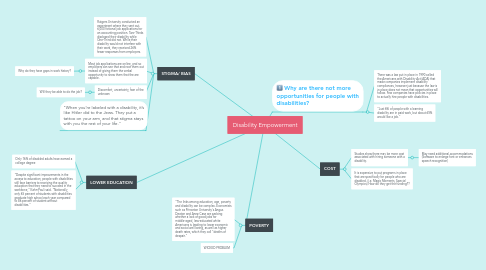Disability Empowerment
by Danika Lambert


1. STIGMA/ BIAS
1.1. Rutgers University conducted an experiment where they sent out 6,000 fictional job applications for an accounting position. Two-Thirds disclosed their disability while One-Third did not. While their disability would not interfere with their work, they received 26% fewer responses from employers.
1.2. Most job applications are online, and so employers can see that and root them out instead of giving them the verbal opportunity to show them that the are capable.
1.2.1. Why do they have gaps in work history?
1.3. Discomfort, uncertainty, fear of the unknown
1.3.1. Will they be able to do the job?
1.4. "When you’re labeled with a disability, it’s like Hitler did to the Jews. They put a tattoo on your arm, and that stigma stays with you the rest of your life."
2. LOWER EDUCATION
2.1. Only 16% of disabled adults have earned a college degree
2.2. "Despite significant improvements in the access to education, people with disabilities still face barriers to receiving the quality education that they need to succeed in the workforce," Kahn-Pauli said. "Nationally, only 65 percent of students with disabilities graduate high school each year compared to 86 percent of student without disabilities."
3. POVERTY
3.1. "The links among education, age, poverty and disability can be complex. Economists such as Princeton University's Angus Deaton and Anne Case are probing whether a lack of good jobs for middle-aged, less-educated white Americans is leading to lower economic and social well being, as well as higher death rates, which they call "deaths of despair."
3.2. WICKED PROBLEM
4. COST
4.1. Studies show there may be more cost associated with hiring someone with a disability.
4.1.1. May need additional accommodations (Software to enlarge font or enhances speech recognition)

